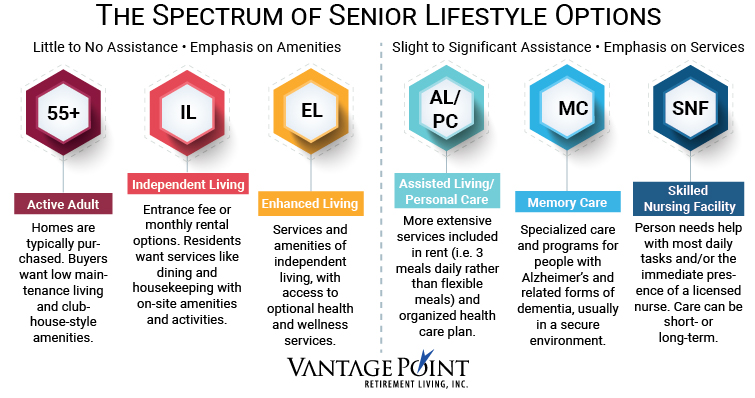If you’re reading this, chances are you’re looking at senior living options for yourself or a loved one. Additionally, if you’re reading this, chances are you’re overwhelmed with the task of sorting through all your options and deciding which type of community is right for you! You might be weighing a lot options right now, such as whether to choose a continuing care retirement community or a month-to-month rental community. Perhaps you’re deciding if you want to purchase a home at a 55+ community or move to an independent living community with many services and amenities. Regardless of how long you’ve been searching and how many places you’ve visited, selecting the type of community that’s right for you is complicated. But the first step to take, if you haven’t already done so, is to narrow down the type of lifestyle you want/need in a community.
As far as lifestyle options go, we at Vantage Point like to look at it as a spectrum that is based on a person’s level of independence (i.e. how much assistance is required daily) and if services or amenities should be emphasized during the consideration process. We’ve created a handy chart that exhibits what we call The Spectrum of Senior Lifestyle Options. You’ll see that this spectrum consists of six different lifestyle categories broken into two sections. Below this diagram are descriptions of each lifestyle category that may be helpful as you consider where you or loved one falls on the spectrum.

Section 1: Little to No Assistance – Emphasis on Amenities
This section consists of lifestyle options for people who are completely, or almost entirely, independent and want to live in a community that provides access to a variety of amenities. In this area of the spectrum, amenities such as a pool, fitness center, game room, theater, salon, and restaurant are more important than services like housekeeping and hands on health care. The farther down the spectrum a lifestyle option is, the more services are emphasized.
- Active Adult – Commonly known as 55+ communities, this lifestyle option is for someone who wants to purchase their own home and no longer wants to deal with the hassles of home maintenance. They don’t want to rake leaves, shovel snow, power wash siding, and clean gutters. What they DO want is to live in a community that has great amenities like a fitness center, pool, game room, and community gathering area. A person who lives in a 55+ community will enjoy the camaraderie of living around people of a similar age, and may even take part in resident run activities and social gatherings, but they are not looking to live in a community that provides extensive services like housekeeping and maintenance.
- Independent Living – A person who moves to an independent living (IL) community doesn’t simply want to get rid of exterior maintenance, they want to be rid of as much home maintenance as possible! That means cooking, cleaning, and even laundry, too. Like active adult communities, an independent living community is amenity-oriented, but goes a step further. In addition to the fitness room, pool, and game room, IL communities will offer service-oriented amenities such as a dining room and full-service salon/spa. And where services in a 55+ community might be limited to exterior home maintenance, an IL community will provide housekeeping services, on-site maintenance, security, and more.
Section 2: Slight to Significant Assistance – Emphasis on Services
This section consists of lifestyle options for people who require at least some assistance with day-to-day tasks and want/need to live in a community that provides the peace of mind that comes with a more service-oriented approach to community living. In this area of the spectrum, services such as nursing available around the clock, emergency health monitoring, and dining with three meals included per day are more important than whether there is a fitness center or pool at the community.
- Assisted Living/Personal Care – Most commonly referred to as assisted living (some states require the term personal care to be used), this lifestyle category is ideal for those who would benefit from living in an environment that is staffed by nurses and aids who are available around the clock. A resident in assisted living receives three meals daily, wears an emergency call pendant, and has a care plan that clearly outlines the support they need daily. Assisted living is staffed by a team of wellness providers who are available at a moment’s notice to tend to the needs of a resident. Apartments in assisted living range in size, but typically do not include a full kitchen since residents receive three meals a day in a dining room. Rather, there is usually a kitchenette with fridge, microwave, and sink to prepare snacks and small meals. While the cost of assisted living/personal care is primarily out of pocket, there are also tax exemptions and certain veteran’s benefits that help offset the costs. In some states, assisted living/personal care can receive federal funding via Medicaid.
- Memory Care – This lifestyle option is ideal for those who have been diagnosed with Alzheimer’s or another form of dementia. Memory care communities are often located within an assisted living community but sometimes stand alone. A person who lives in a memory care community receives many of the same services and amenities as a person who lives in an assisted living community but may have a history of wandering or would benefit from programs geared towards those with memory impairments. These types of communities are typically secured to keep those who may wander safe, with access in and out granted to those with a key code. While the cost of memory care is primarily out of pocket, there are also tax exemptions and certain veteran’s benefits that help offset the costs. In some states, memory care can receive federal funding via Medicaid.
- Skilled Nursing Facility – The last option on the senior living spectrum is skilled nursing. This category of senior living can be short-term or long-term in nature. Seniors who require short-term skilled nursing typically need to rebuild strength after being in the hospital for an extended period because of an illness such as pneumonia or following a surgery such as a joint replacement. In this environment, patients receive regular therapy to help them recuperate to a point where they may return home or move to an assisted living/personal care community. A person may need skilled nursing on a long-term basis if the amount of hands-on assistance they need is more than what can be provided in assisted living. Common examples include feeding tubes and continuous IV’s. Additionally, skilled nursing facilities receive federal funding and are reimbursed by Medicare and Medicaid. In many states, assisted living/personal care is primarily out of pocket, so some seniors choose long-term skilled nursing because of financial considerations.
With all the options out there it is easy to understand why seniors and their family members are confused and overwhelmed during the process of finding the community that meets their needs. Hopefully this article helped shine some light on the different options! Vantage Point is proud to offer communities in five of the six lifestyle categories on the senior living spectrum: active adult, independent living, assisted living and memory care. For more information on these communities email [email protected] or call 610-321-1977.



